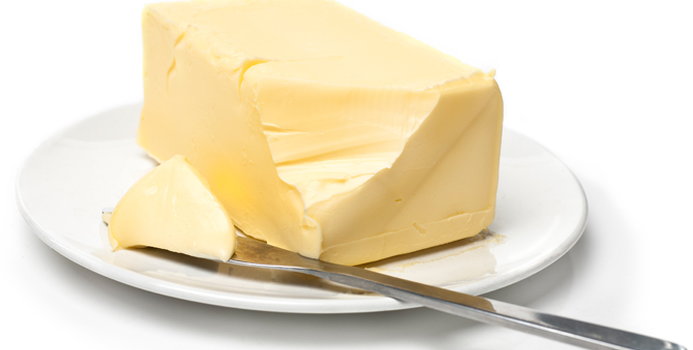The production of margarine can be traced back to the time of Napoleon in the 1860s. It was created as an affordable alternative to butter. Margarine is made from vegetable fat instead of cow's milk, which is what butter is created from.
Margarine is produced by combining several different types of vegetable oils. Two of the most common oils used for margarine are corn and soybean oil. The oil is first hydrogenated, a chemical process where hydrogen gas is forced into unsaturated fatty acids to make the oil become partially saturated. The reason margarine goes through this process is so that it can achieve a solid texture at room temperature, allowing for a similar appearance and consistency of butter.
Nutritional Value of Margarine
One ounce of margarine has the following nutritional value:
- 150 calories
- 17 g fat
- 3 g saturated fat
- 8.3 g monounsaturated fat
- 4.7 g polyunsaturated fat
- 504 mg omega-3 fatty acids
- 4177 mg omega-6 fatty acids
- 0 mg cholesterol
- 1 mg sodium
- 0g carbohydrates
- 0 g fiber
- 0 g sugar
- 0 g protein
One ounce of margarine provides you with 35% of your daily recommended dose of vitamin K, 20% of your daily recommended dose of vitamin A and 1% of your daily recommended dose of calcium.
Health Benefits of Margarine
Most margarines are composed of approximately 80% fat. This fat is a combination of saturated and unsaturated fats. The saturated fats in margarine can range from 7 to 86 percent, depending on the type of vegetable that is used. Coconut and palm kernel oil have higher amounts of saturated fat than canola or sunflower oil. The fat in margarine contains vitamin A, vitamin D, vitamin E and vitamin K.
Margarine has alpha-lineolic acid, or ALA, which is an omega-3 fatty acid. Omega 3 fatty acids have shown to lower total cholesterol levels, triglycerides and reduce inflammation. Some commercial brands of margarine also have flax seed oil or fish oil added to them to increase the amounts of healthy omega-3 fatty acids.
Many commercial brands of margarine have plant sterol added to their oils. Plant sterol has been shown to lower cholesterol levels.
Negative Aspects of Margarine
The process of hydrogenation causes margarine to become saturated and contain trans fats, which can be harmful to the body. Trans fat has shown to increase the risk of heart disease, increase bad cholesterol, or LDL levels, reduce good cholesterol, or HDL, and increase your risk of certain cancers and chronic illnesses.
Cooking with Margarine
Margarine can be used as a replacement of butter in baking or cooking. Additionally, margarine can be used as a spread or condiment on muffins, bagels or biscuits or as a topping for baked potatoes or vegetables.



